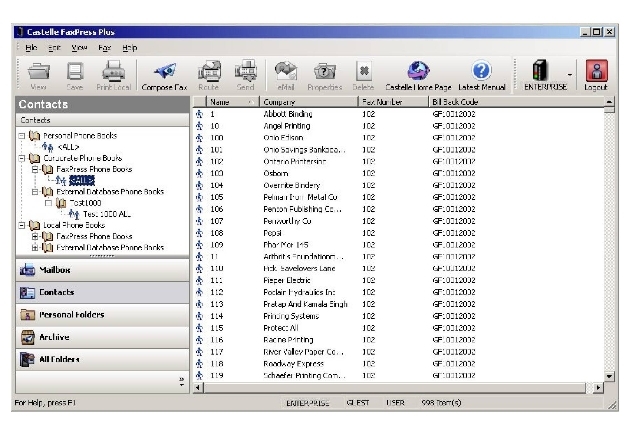FaxPress Enterprise’s phone books provide convenient access to the contacts and fax numbers frequently used for fax addressing. The phone books can all be accessed from the Enterprise client’s Send Fax interface. See Sending Faxes for information on accessing the Send Fax interface.

The phone book groups include:
Personal Phone Books – These are individual FaxPress Enterprise phone books (per user) that you manage, and which are stored on the FaxPress Enterprise server. These are available (because they are stored on the FaxPress Enterprise server) to you no matter where you login to FaxPress Enterprise. Your personal phone books are located under the Mailbox branch in the Personal Phone Books folder.
Local Phone Books – These are individual FaxPress Enterprise or database phone books that you manage, and which are stored on your desktop. These are only available if you login to FaxPress Enterprise from your own workstation. Local Phone Books are managed through FaxPress Plus under the Personal Folders branch in the Local Phone Books folder. To access these phone books There are two types of Local Phone Books (as with Corporate Phone Books):FaxPress Phone Books and External Database Phone Books.
Corporate Phone Books – Corporate phone books are shared by all. They are created by the FaxPress Enterprise Administrator. They are accessed under the Corporate Phone Books branch for the general user. There are two different types of Corporate Phone Books:
| ■ | the FaxPress Phone Books |
| ■ | External ODBC Database Phone Books. |
For more information, refer to Creating Corporate Phone Books in the FaxPress Enterprise Administrator’s Guide.
Exchange and Outlook Contact Lists – You can access Exchange and Outlook contact list through FaxPress Plus, but you manage them through your email server or client. To access your contact lists for sending a fax, change your phone books options in your personal preferences to Exchange/Outlook. See Setting Personal Preferences.
Type of Phone Books
You have probably noticed by now that FaxPress Enterprise has two different types of phone books available within the phone book groups: FaxPress Enterprise Phone Books and External Database Phone Books.
FaxPress Phone Books – The FaxPress Phonebooks are the internal phonebooks used by FaxPress Enterprise. All internal phonebooks can be imported and exported. FaxPress phone books can be managed from Local Phone Books, Personal Phone Books, and Corporate Phone Books. You can import, export and manually add users and groups to these phone books. The available file formats for importing into FaxPress Phone Books are:
| ■ | Standard Comma Delimited Files (*.csv) |
| ■ | Custom Comma Delimited Files (*.csv) |
| ■ | dBase Files (*.dbf) |
| ■ | ExportPH Files (*.*)— This is a FaxPress Enterprise 3.x exported phone book |
External ODBC Database Phonebooks – FaxPress Enterprise can access your ODBC database phone books using an ODBC driver. The database can be many types, Microsoft Access, Microsoft SQL Server, or simply an Excel spreadsheet. You must have the specific ODBC driver loaded on your client machine to access these phone books through FaxPress Enterprise database phone books. Database access is available through both Corporate Phone Books and Local Phone Books.
The FaxPress Enterprise can be configured to automatically format phone numbers to include area codes, external line access, international codes, PBX codes and passwords. If you would rather embed all the dialing rules in your phonebooks, use the following phone number format information.
We recommend that numbers have separators between the various parts. Legal separators are:
| ■ | A single or multiple space character(s) |
| ■ | A dash — |
| ■ | Brackets ( ) |
Other, non numeric characters which may be in an entered number are:
| ■ | $ (Dollar sign)— FaxPress Enterprise replaces the PBX password with the dollar sign. |
| ■ | % —this can also be used for PBX password substitution. |
| ■ | # —by default this dials the # key like the one found on most phone keypads. This character can also be used as the separator character to indicate T.30 sub addressing. |
| ■ | *— by default this dials the * key like the one found on most phone keypads. |
| ■ | , (comma). This inserts a 3 second pause in the dialing. No comma is needed in the PBX pre dial; there is already an implied pause. |
|
FaxPress Enterprise & Enterprise Redundant WebHelp
Last Updated: 11/1/2007
E-mail this page |
Castelle 855 Jarvis Drive, Suite 100 Morgan Hill, CA 95037 Toll-free 800.289.7555 Tel 408.852.8000 Fax 408.852.8100 |